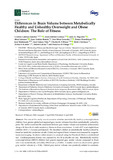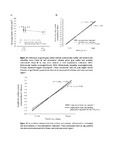Mostrar el registro sencillo del ítem
Differences in brain volume between metabolically healthy and unhealthy overweight and obese children: the role of fitness
| dc.creator | Cadenas-Sánchez, Cristina | es_ES |
| dc.creator | Esteban Cornejo, Irene | es_ES |
| dc.creator | Migueles, Jairo H. | es_ES |
| dc.creator | Labayen Goñi, Idoia | es_ES |
| dc.creator | Verdejo Román, Juan | es_ES |
| dc.creator | Mora González, Jose | es_ES |
| dc.creator | Henriksson, Pontus | es_ES |
| dc.creator | Maldonado, José | es_ES |
| dc.creator | Gómez Vida, José | es_ES |
| dc.creator | Hillman, Charles H. | es_ES |
| dc.creator | Erickson, Kirk I. | es_ES |
| dc.creator | Kramer, Arthur F. | es_ES |
| dc.creator | Catena, Andrés | es_ES |
| dc.creator | Ortega, Francisco B. | es_ES |
| dc.date.accessioned | 2020-07-06T08:41:18Z | |
| dc.date.available | 2020-07-06T08:41:18Z | |
| dc.date.issued | 2020 | |
| dc.identifier.issn | 2077-0383 | |
| dc.identifier.uri | https://hdl.handle.net/2454/37329 | |
| dc.description.abstract | The aim of this study was to examine whether metabolically healthy overweight/obese children have greater global and regional gray matter volumes than their metabolically unhealthy peers. We further examined the association between gray matter volume and academic achievement, along with the role of cardiorespiratory fitness in these associations. A total of 97 overweight/obese children (10.0 +/- 1.2 years) participated. We classified children as metabolically healthy/unhealthy based on metabolic syndrome cut-offs. Global and regional brain volumes were assessed by magnetic resonance imaging. Academic achievement was assessed using the Woodcock-Munoz standardized test. Cardiorespiratory fitness was assessed by the 20 m shuttle run test. Metabolically healthy overweight/obese (MHO) children had greater regional gray matter volume compared to those who were metabolically unhealthy (MUO) (all p <= 0.001). A similar trend was observed for global gray matter volume (p = 0.06). Global gray matter volume was positively related to academic achievement (beta = 0.237, p = 0.036). However, all the associations were attenuated or disappeared after adjusting for cardiorespiratory fitness (p > 0.05). The findings of the present study support that metabolically healthy overweight/obese children have greater gray matter volume compared to those that are metabolically unhealthy, which is in turn related to better academic achievement. However, cardiorespiratory fitness seems to explain, at least partially, these findings. | en |
| dc.description.sponsorship | The ActiveBrains project was funded by the Spanish Ministry of Economy and Competitiveness and the 'Fondo Europeo de Desarrollo Regional (FEDER)' (DEP2013-47540, DEP2016-79512-R, DEP2017-91544-EXP and RYC-2011-09011). CC-S are supported by the Government of Andalusian, Integrated Territorial Initiative 2014-2020 for the province of Cadiz (PI-0002-2017) and the Spanish Ministry of Science and Innovation (FJC2018-037925-I). IE-C are supported by the Alicia Koplowitz Foundation and the Spanish Ministry of Economy and Competitiveness (RTI2018-095284-J-100). JHM and JM-G are supported by the Spanish Ministry of Education, Culture and Sport (FPU15/02645 and FPU14/06837, respectively). JVR is supported by a grant from the Spanish Ministry of Science, Innovation and Universities (FJCI-2017-33396). PH was supported by a grant from the Strategic Research Area Health Care Science, Karolinska Institutet/Umea University. Additional funding was obtained from the University of Granada, Plan Propio de Investigacion 2016, Excellence actions: Units of Excellence; Scientific Excellence Unit on Exercise and Health (UCEES). Junta de Andalucia, Consejeria de Conocimiento, Investigacion y Universidades and European Regional Development Funds (ref. SOMM17/6107/UGR). In addition, funding was provided by the SAMID III network, RETICS, funded by the PN I + D + I 2017-2021 (Spain), ISCIII-Sub-Directorate General for Research Assessment and Promotion, the European Regional Development Fund (ERDF) (Ref. RD16/0022), the EXERNET Research Network on Exercise and Health in Special Populations (DEP2005-00046/ACTI) and the European Union's 2020 research and innovation program under grant agreement No 667302. | en |
| dc.format.extent | 15 p. | |
| dc.format.mimetype | application/pdf | en |
| dc.language.iso | eng | en |
| dc.publisher | MDPI | en |
| dc.relation.ispartof | Journal of Clinical Medicine, 2020, 9(4), 1059 | en |
| dc.rights | © 2020 by the authors. Licensee MDPI, Basel, Switzerland. This article is an open access article distributed under the terms and conditions of the Creative Commons Attribution (CC BY) license. | en |
| dc.rights.uri | http://creativecommons.org/licenses/by/4.0/ | |
| dc.subject | Academic achievement | en |
| dc.subject | Cardiorespiratory fitness | en |
| dc.subject | Global volume | en |
| dc.subject | Gray matter | en |
| dc.subject | Regional volume | en |
| dc.title | Differences in brain volume between metabolically healthy and unhealthy overweight and obese children: the role of fitness | en |
| dc.type | info:eu-repo/semantics/article | en |
| dc.type | Artículo / Artikulua | es |
| dc.contributor.department | Institute on Innovation and Sustainable Development in Food Chain - ISFOOD | es_ES |
| dc.rights.accessRights | info:eu-repo/semantics/openAccess | en |
| dc.rights.accessRights | Acceso abierto / Sarbide irekia | es |
| dc.identifier.doi | 10.3390/jcm9041059 | |
| dc.relation.projectID | info:eu-repo/grantAgreement/MINECO//DEP2013-47540-R/ES/ | en |
| dc.relation.projectID | info:eu-repo/grantAgreement/ES/1PE/DEP2016-79512-R | en |
| dc.relation.projectID | info:eu-repo/grantAgreement/ES/2PE/DEP2017-91544 | en |
| dc.relation.projectID | info:eu-repo/grantAgreement/European Commission/Horizon 2020 Framework Programme/667302 | en |
| dc.relation.publisherversion | https://doi.org/10.3390/jcm9041059 | |
| dc.type.version | info:eu-repo/semantics/publishedVersion | en |
| dc.type.version | Versión publicada / Argitaratu den bertsioa | es |




